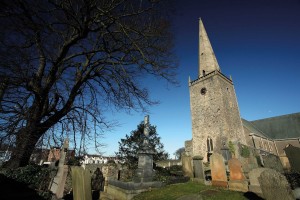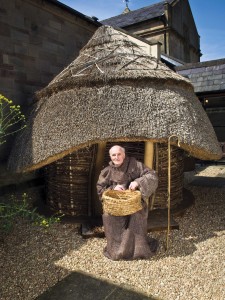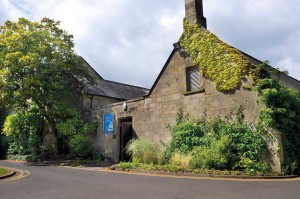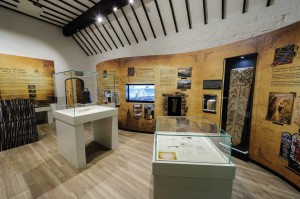North Down Museum
Published in Issue 1 (January/February 2015), Reviews, Volume 23Town Hall, the Castle, Bangor, Co. Down
www.northdownmuseum.com museum@northdown.gov.uk

Bangor Abbey, centre-piece of the new exhibition, which also covers the wider medieval monastic movement in Ireland and the role played by Irish saints in reintro-ducing Christianity to the European mainland.
North Down Museum recently celebrated its 30th year and it is one of the most successful local museums in Ireland. It is historic in itself, being situated in converted outbuildings of Bangor Castle. The museum covers a number of themes on the history and heritage of this part of County Down: early Christianity, the Bronze Age, the Vikings, landed families, the natural world and so on.
To mark the anniversary of its opening, the museum is highlighting its new exhibition on early Christianity and I went along to see that. Although concentrating on Bangor Abbey, it covers more than that, as it takes in the medieval monastic movement in Ireland and the role played by Irish saints in reintroducing Christianity to the European mainland, with information panels on St Columbanus and St Gall, for example.
The gallery is not a large room but there is a lot packed into it. First of all, in the courtyard outside is a life-size reconstruction of an Irish monk’s cell from the heyday of the Irish monastery. On certain days a ‘real-life’ monk is on hand to explain about monastic life all those centuries ago. In the room itself, the walls are lined with large, bright, colourful information panels, which give details of the history of Christianity in Ireland, the growth and later suppression of Bangor Abbey, and the Irish role in Europe. We learn that Bangor, or Beannchor in Irish, was probably the ‘valley of the angels’ seen by St Patrick in a vision and so was an appropriate place for St Colmgall to found a monastery in AD 558. That became one of the most important in Ireland, ranking alongside the likes of Armagh and Clonmacnoise, and became a major seat of learning, with scholars from across Europe coming there to study.
An interactive screen explores the themes of learning and missionary work, complementing the panels on SS Columbanus, Gall, Malachy and Colmgall. Via the screen, you can follow the journeys of these saints as they left Ireland to spread the word of God and visit the monasteries they founded in Europe, such as Luxeuil, Bobbio and St Gallen (which is now a UNESCO World Heritage Site). The screen also has images of manuscripts and artefacts from these foundations.
There are plenty of ‘real’ objects too, however. Pride of place goes to a bronze bell such as would have been used to call the monks to prayer over a millennium ago. The site of the ancient abbey and of nearby Gransha Mound have been intensively excavated by archaeologists, revealing finds such as 30 skeletons, pottery and metalwork. Most significant was the discovery of a lead stylus, which was used in producing the manuscripts and books for which the abbey was famous, such as the seventh-century Bangor Antiphony, which contains the ‘Three Hymns of the Monastery of Bangor’.
Many of the finds from the excavations are on display in the cases in the gallery, with examples of pottery, carved stones, loom-weights, Bronze Age pins, buckles and brooches. In niches in the wall are a replica of the bell of St Columbanus, a carved stone altar cross, a carved medieval head and a stone coffin lid believed to date from the sixth century. Look out, too, for the seal and matrix of John Kennedy, abbot of Bangor, from around 1395.

The life-size reconstruction of an Irish monk’s cell in the courtyard outside. On certain days a ‘real-life’ monk is on hand to explain about monastic life all those centuries ago.
(All images: North Down Museum)
A large model at one end of the gallery shows what the monastery would have been like in the medieval period. It explains its location by a river, on which there was a mill, and highlights the key buildings that the monks would have used, such as the chapel, the cells, the scriptorium (where manuscripts were written or copied) and the guesthouse. The latter was important, since Bangor’s growing renown attracted pilgrims and visitors from across Europe.
The monastery’s history was not just one of learning and renown, however. It suffered at the hands of the Vikings, and later neglect left the monastery in ruins. It underwent a second foundation at the hands of the great church reformer St Malachy, who rebuilt its church in 1137. The abbey survived the various vicissitudes of Irish history until the reign of Henry VIII saw the dissolution of Catholic monasteries in Ireland and Britain. Much of its land was granted to James Hamilton, who is credited with being the founder of the modern town of Bangor.
This is an informative and interesting exhibition that covers a millennium of history in an access-ible and understandable way. There is a good mix of panels, screens and artefacts, enabling the visitor to take in as much or as little as they please. On my visit a family was also there and the children were as taken by the models, the replicas and the actual artefacts as were the adults.
Of course, the entire museum is worth a visit. There is the same high standard of exhibition throughout, and you will certainly by surprised at the depth of history in North Down and the significance of Bangor through the centuries. With ten separate galleries there is a lot of walking to do, but the museum also has an excellent café where you can rest your feet and enjoy a snack after your voyage through the centuries.
Tony Canavan is the editor of Books Ireland.


















